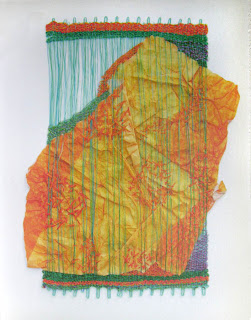Monday, May 9, 2011
Lorie McCowen
from Artist's Statement:
"I chose fiber as a means to convey the tactile quality in a piece as well as the symbology of the fibers which create it. Fiber is such an elemental, base material; it lends itself to infinite possibilities of expression. Ancient civilizations’ production of fiber and both its cultural uses and its everyday workings are always in my mind when producing the work. I dye my own fabrics as well as use commercial fabric for the work.
Each project often consists of multiple works, often in a range of different fiber, grouped around specific themes and meanings. During research and production, new areas of interest arise and lead to the next body of work. The idea of capturing the beauty in the overlooked landscape is a driving force to many of my pieces. There is feeling of reminiscence and familiarity to my quilts because they are of subjects that everyone has seen or driven past, or seen before."
(more here)
Incarcerated Women's Weaving
"Women are the fastest growing segment of the burgeoning jail and prison population in the United States. Since 1980, female numbers have increased at twice the rate of men's -- and Texas now has more incarcerated women than any other state.
Few incarcerated women have committed violent offenses; their primary pathway to incarceration is substance abuse. Poverty, trauma, mental health issues and addiction are interrelated problems in their lives - and these problems are often exacerbated by their incarceration.
Evidence shows that gender-sensitive rehabilitative programs that address the issues underlying addiction can make a positive difference in the lives of these marginalized women. But in a correctional system designed for and dominated by men, women remain an underserved population.
For more than three years, Resolana has provided holistic woman-centered programming to incarcerated women at Dallas County Jail and, previously, at Dawson State Jail. Resolana turns women's time in custody into an opportunity to acquire the insight and self-discipline, skills and confidence to begin turning their lives around. For many, it is the best - or the only - opportunity they will ever have."
(more here and here)
Aude Franjou
'Aude-Marie Franjou is a fiber artist based in Château Landon, a small town nearby Paris. Aude studied Art History and Tapestry in Paris, before starting exploring the sculptural possibilities of linen threads and ropes.
Aude Franjou creates organic tri-dimensional forms, made of hemp fiber wrapped with linen threads, which are often a part of a open dialogue with Nature. Her works can normally be found in parks and gardens, wrapping trees and houses
” I start with a clear idea and then I just follow and react to what the material wants, to its reactions and movements. Sometimes I constrain this. Other times I just let myself go.” '
(more here and here)
Carol Shaw Sutton
"Carol Shaw-Sutton's artwork often consists of personal narrative objects and installations utilizing both ancient and more modern textile techniques that require a labor-intensive commitment of focus and time. Their goal is to simultaneously value and at the same time, transcend the notion of time and space. In a visually poetic language they deal with deep human concerns for harmony and release through the body and spirit. Counting, longing, journeying, scarring, repairing, caring, crossing and empathy have become recurrent themes in her work.
Carol Shaw-Sutton works intuitively and makes objects that are laden with meaning." (more here)
Shelia Hicks
"Known for her use of distinctive colors, experimental and natural materials, and personal narratives, these intriguing weavings reveal the emergence and continuity of the artist’s inventive approach to textile media, and a
unique connection between the artistic and design aspects of textiles. Her work is diverse, switching between miniatures and gigantic. Using a portable frame loom of her own design, Hicks employs a remarkably broad range of materials as well, such as cotton, wool, linen, silk, goat hair, alpaca, paper, leather, stainless steel, and found objects. All of which she turns into woven works of considerable beauty and intricate detail." (from here)
Subscribe to:
Posts (Atom)




















